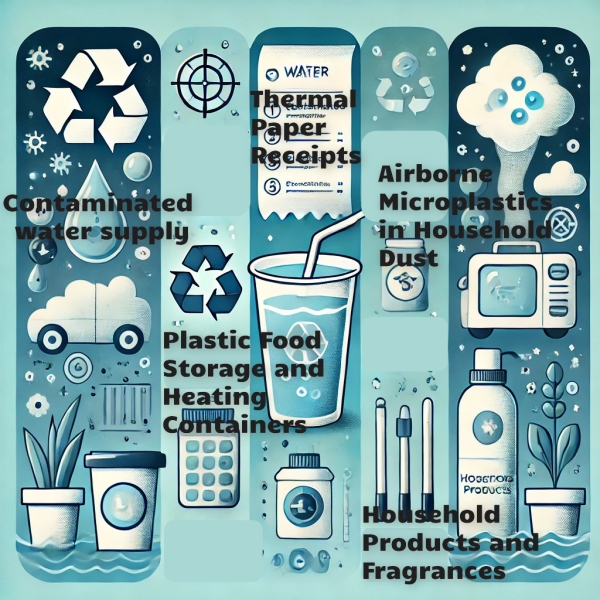

Microplastics have infiltrated nearly every aspect of our environment, from the water to the air we breathe. These tiny plastic particles and their associated chemicals significantly threaten human health, disrupting hormonal balance, increasing toxicity levels, and even affecting neurological function. Fortunately, by understanding the most common sources of microplastics, you can take proactive steps to minimize your exposure and protect your well-being.
Microplastics are tiny plastic particles, often less than 5mm in size, originating from various sources, including product packaging, industrial waste, and everyday household items. They can be classified into two categories:
Common chemicals associated with plastic exposure include bisphenol A (BPA), phthalates, and polyfluoroalkyl substances (PFAS). Even products labeled as “BPA-free” may contain alternative chemicals that can still pose health risks.
Here are the top five sources of microplastic exposure and practical ways to limit your contact with these harmful substances.
One of the most significant sources of microplastic exposure is drinking water. Studies have found microplastics in tap and bottled water, as well as contaminants such as pharmaceutical residues, heavy metals, and fluoride. Despite municipal filtration efforts, many pollutants still enter household water supplies.
Many cash register receipts are coated with BPA or similar chemicals to prevent fading. Unfortunately, these compounds are easily absorbed through the skin and have been linked to hormonal imbalances, fertility issues, and metabolic disorders.
Plastic containers, especially those exposed to heat, can leach microplastics and harmful chemicals into food. This is particularly true for microwaving food in plastic or storing leftovers in low-quality plastic containers.
Airborne microplastics in household dust can originate from furniture, synthetic fabrics, and household cleaning products. Breathing in these particles daily may contribute to respiratory issues and toxicity accumulation over time.
Many personal care and household products contain microplastics, including synthetic fragrances, detergents, and air fresheners. These chemicals can enter the body through inhalation, skin contact, or ingestion.
Beyond human health concerns, microplastics are wreaking havoc on the environment. These particles accumulate in oceans, rivers, and soil, harming wildlife and disrupting ecosystems. Marine life, in particular, is at risk as fish and other aquatic organisms mistake microplastics for food, leading to bioaccumulation in the food chain—potentially ending up on our dinner plates.
While microplastics are nearly impossible to avoid entirely, small changes can significantly reduce daily exposure and protect your health. Investing in a high-quality water filter, avoiding plastic food storage, improving indoor air quality, and being mindful of household products can make a meaningful impact on your well-being and the environment.
By taking proactive steps today, you safeguard your health and contribute to a cleaner, healthier planet. Stay informed and make smarter choices to minimize exposure to microplastics and other harmful chemicals. Every small action counts in the fight against plastic pollution!
Rochman, C.M., et al. (2015). “Anthropogenic debris in seafood: Plastic debris and fibers from textiles in fish and shellfish.” Scientific Reports.
🔗 https://www.nature.com/articles/srep14340
Smith, M., et al. (2018). “Microplastics in drinking water: A review of current understanding.” Environmental Science & Technology.
🔗 https://pubs.acs.org/doi/10.1021/acs.est.8b02735
Galloway, T.S., & Lewis, C.N. (2016). “Marine microplastics: The threats they pose to human health.” Environmental Health Perspectives.
🔗 https://ehp.niehs.nih.gov/doi/10.1289/ehp.1104265
Campanale, C., et al. (2020). “A detailed review study on potential effects of microplastics and additives of concern on human health.” International Journal of Environmental Research and Public Health.
🔗 https://www.mdpi.com/1660-4601/17/4/1212
World Health Organization (WHO). (2019). “Microplastics in drinking water.”
🔗 https://www.who.int/publications-detail/microplastics-in-drinking-water
=======================
Recommended Products: